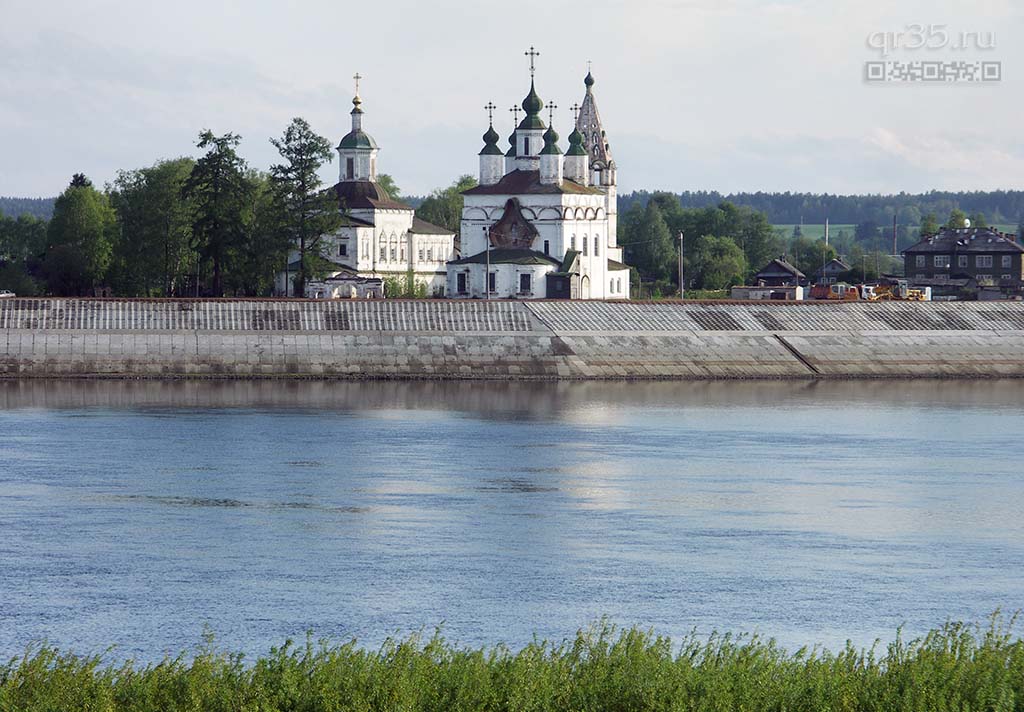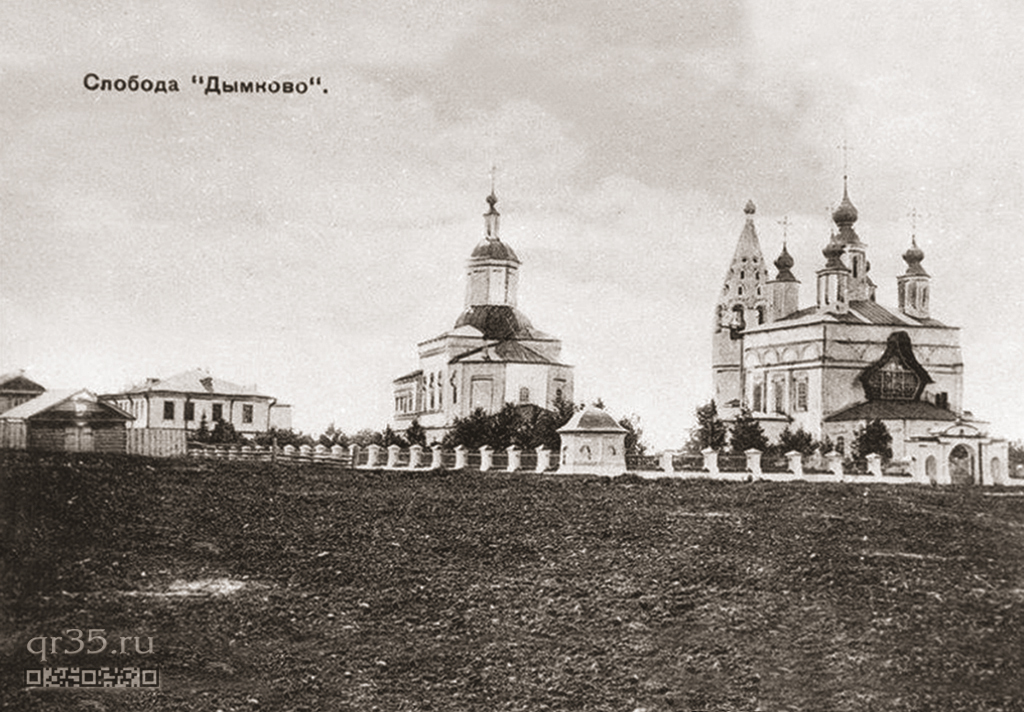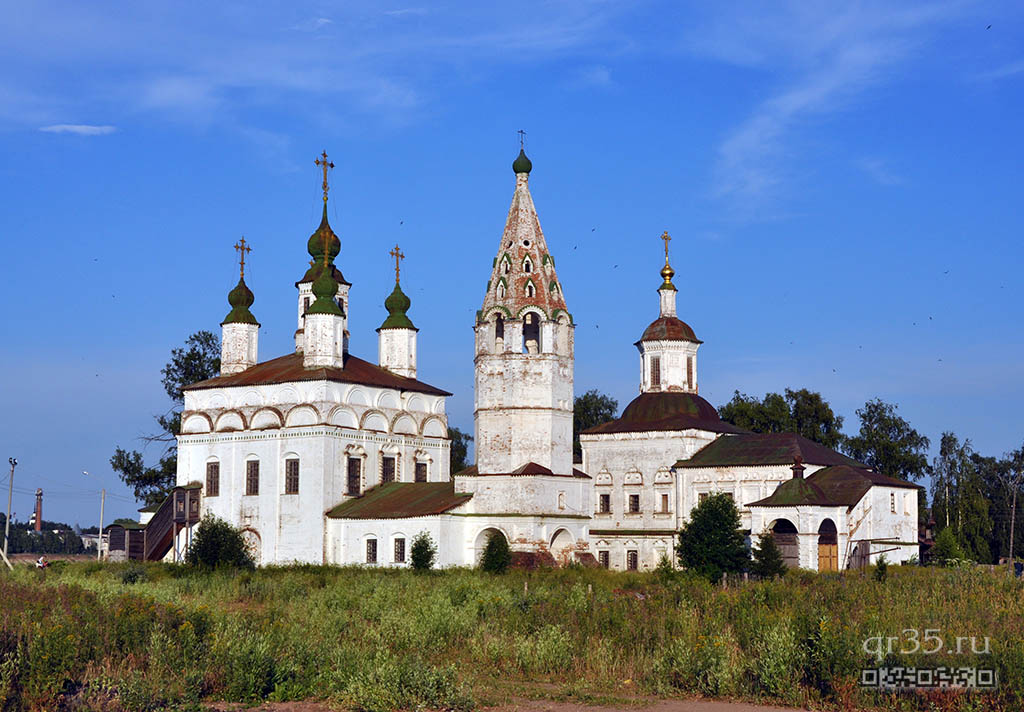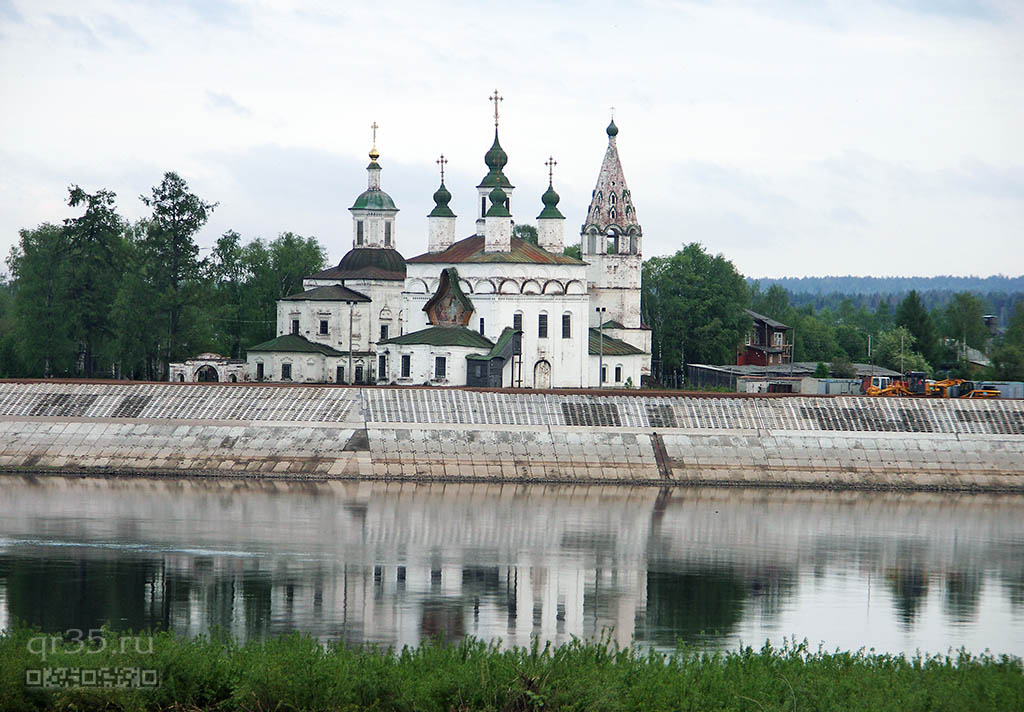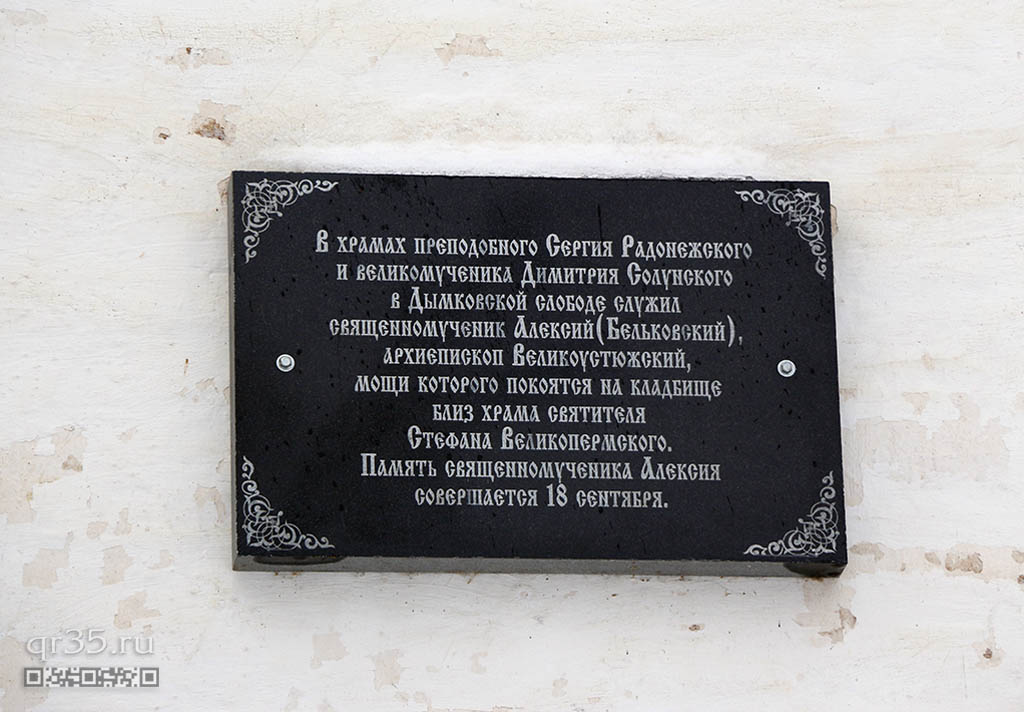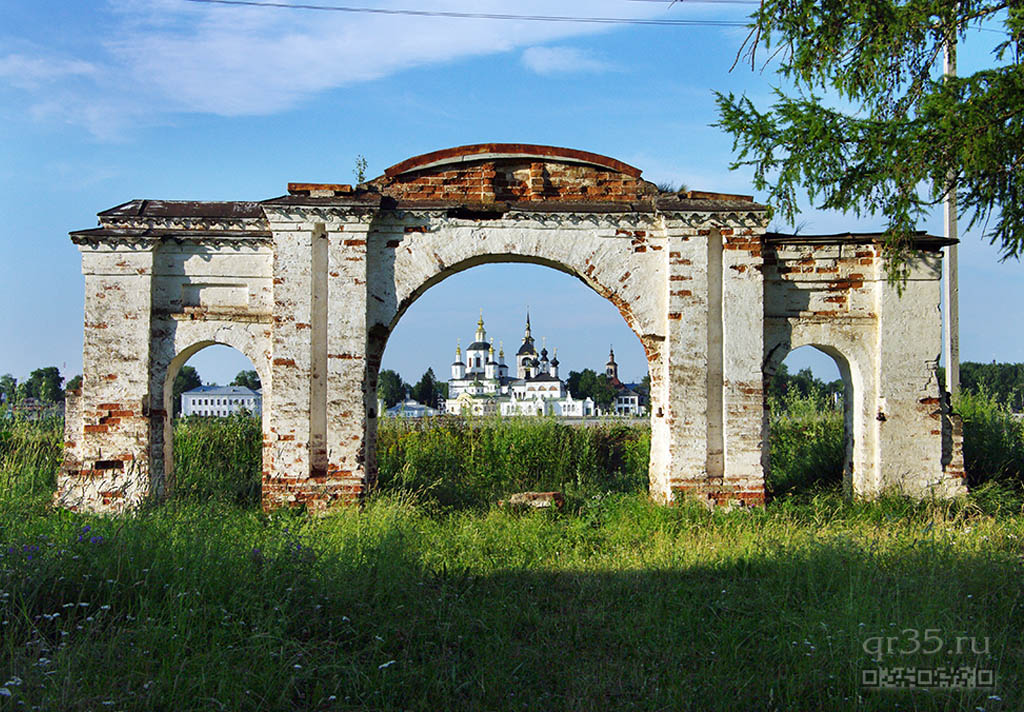The Ensemble of the Churches at Dymkovo
GENERAL INFORMATION
Dating: the first half of the 18th century.
Type: An ensemble.
Status: a cultural heritage site of federal importance.
Address: 1 Pervaya St., Dymkovo Sloboda, V. Ustyug, Russia.
Part of the ensemble: the Church of Saint Dmitry Solun, the Church of Saint Sergius Radonezh.
Brief description.
The view of Dymkovo from the embankment of Veliky Ustiug is one of the landmarks of the town. The peculiar to the north ensemble consists of two temples: a bigger one - unheated and a smaller one – heated. It was formed on the principles established in the era of Ancient Rus’. From Dymkovo, in turn, there is a picturesque view of the town.
Condition: satisfactory.
Contemporary use: the ensemble is used by the Veliky Ustiug State Museum-Reserve.
HISTORY
It is believed that the first wooden churches at Dymkovo were built in 1383 in memory of Ustiug people’s participation in the battle of Kulikovo, which took place on 8 (16) September 1380. The dedication of the churches to Saint Dmitry Solun and Saint Sergius Radonezh indicates that the parish could really have been established either under the reign of Grand Prince Dmitry Donskoy (1350-1389) or his closest relatives and descendants. Saint Dmitry Solun was venerated as a patron saint of the Grand Prince. And social activities of Saint Sergius Radonezh (approx 1314-1392, revered as a saint since the mid-15th century) were aimed at supporting the unification of Ancient Rus' around the princely house. Saint Sergius testified Prince Dmitry’s Testament, which set a new order of succession to the throne, with his signature. For a long time Dymkovo was part of the princely family’s property. Dymkovo was first mentioned in 1461 in the Testament of Grand Prince Vasily the Dark, Dmitry Donskoy’s grandson.
The churches were built anew several times, after dilapidation or fires. According to the chronicles, in 1539, “the Kazan Tatars and the Cheremeses... burned those two churches in Dymkovo suburb, the Church of the Holy Martyr Dmitry, and also the warm Church of St. Sergius, Wonderworker». The oldest description of the Dymkovo churches is preserved in the census book of 1630: surrounded by a wooden fence and a cemetery there were “the Church of Saint Dmitry Solun, Wonderworker, a wooden summer one, and the warm Church of Staint Sergius Radonezh, Wonderworker, a wooden winter one» and a freestanding «chopped hipped bell tower, with 7 bells on it».
The extant stone cold (unheated summer) church at Dymkovo was built in 1700-1708. In the middle of the 18th century to the south of the cold church the warm (heated winter) Church of Saint Sergius Radonezh was erected.
In 1859 on the donations of merchants Ilya Yakovlevich Gribanov and Pavel Maksimovich Zhilin a stone fence with gates on the south and east sides and two small towers on the south-east and north-east fence corners were built around the churches.
In 1930 the churches were closed. At present the ensemble is assigned to Veliky Ustiug State Museum-Reserve and is used for the external display.
DESCRIPTION
The ensemble of Dymkovo churches is located on the right bank of the Sukhona River in Dymkovo Sloboda. The cold Church of Saint Dmitry Solun, which is the main church of the parish, dominates the ensemble. Next to it (to the south) there is a warm Church of Saint Sergius Radonezh of a smaller size. On the east side of the Dymkovo churches there is a stone gate of the dismantled fence, which used to have a south-east corner tower, now partially extant.
LOSS, RECONSTRUCTION, RESTORATION
In the 19th century in both churches several openings were laid, and buttresses of the pylons of the bell tower emerged. In the twentieth century, when the churches were closed, the bells were removed from the bell tower. Many elements of the interiors were destroyed, including the iconostasis of the Church of Saint Sergius. The stone fence surrounding the ensemble was disassembled. There the eastern gate and the partially preserved south-east corner tower are only left. In 1983-1986 restoration works were carried out in the ensemble churches under the leadership of the architect Eduard Eduardovich Nasedkin.
At the beginning of the 21st century the right bank of the Sukhona River was strengthened with concrete structures. This prevented the erosion of the bank in the flood, but changed the traditional view of the architectural ensemble from the opposite bank of the river.
Text by Marina Vasiliyeva.
Translated by Olga Leonidova.
Sources and Literature
- Ардашев. Летопись семисотлетнего существования города Устюга Великого // Вологодские губернские ведомости. 1857. № 34–52.
- Батаков Н., Мансветова Е., Широков В. Великий Устюг. Вологда, 1960.
- Бестужева Ю.А. Деятельность Музея северодвинской культуры по сохранению памятников культового зодчества в Великом Устюге в 1920–1930-х годах // Великий Устюг: краеведческий альманах. Вологда, 2007. Вып. 4. С. 175–194.
- Бочаров Г.Н., Выголов В.П. Сольвычегодск. Великий Устюг. Тотьма. М., 1983.
- Брюсова В.Г. Икона «Дмитрий Солунский на престоле» из Великого Устюга // Русское искусство XI–XIII веков: сб. ст. М., 1986.
- Булкин В.А., Чугунов Г.И. Великий Устюг. Л., 1978.
- Вологодские епархиальные ведомости. Прибавления. № 13. 1915.
- Вологодский календарь на 1894 г. Вологда, 1893.
- Город Великий Устюг в церковном отношении // Вологодский иллюстрированный календарь на 1894 год. Вологда, 1893. С. 27–31.
- Дунаев Б.И. Северо-Двинское гражданское и церковное зодчество. Город Великий Устюг // Древности. Труды комиссии по сохранению древних памятников, состоящей при Императорском Московском Археологическом обществе. Т. VI. М., 1915.
- Дымково // Официальный сайт Великоустюгского музея-заповедника.
- Капустина А.В., Сыроватовская Л.Н., Чебыкина Г.Н. Великий Устюг. Великий Устюг, 2007.
- К истории города Великого Устюга (список литературы) / сост. Э.А.Волкова // Великий Устюг: краеведческий альманах. Вологда, 2000. Вып. 2. С. 357–378.
- Непеин А. Святыни и достопримечательности города Великого Устюга и его окрестностей. Вологда, 1915.
- Онаш К. Иконостасы Великого Устюга // Великий Устюг: краеведческий альманах. Вологда, 1995. Вып. 1. С. 180–194.
- Описание города Устюга Великаго Вологодской губернии в историческом, статистическом и топографическом отношениях / введение И.С.Велиевой и Ю.С.Васильева, публикация И.С.Велиевой, комментар ий Ю.С.Васильева // Великий Устюг: краеведческий альманах. Вологда, 1995. Вып. 1. С. 379–459.
- Парийский И. Руководство к историческому и физическому описанию областного города Устюга Великого, сочиненное в 1793 году. СПб., 1899.
- Паспорт памятника истории и культуры г. В. Устюга: церковь Дмитрия Солунского / сост. И.Б. Медведев. 1984. // Архив АУК ВО «Вологдареставрация», отдел учёта.
- Паспорт памятника истории и культуры г. В. Устюга: церковь Сергия Радонежского / сост. И.Б. Медведев. 1984. // Архив АУК ВО «Вологдареставрация», отдел учёта.
- Подъяпольский С.С. По Сухоне и Северной Двине. М., 1969.
- Попов А. Дымковская Димитриевская церковь в г. Устюге // Прибавления к Вологодским епархиальным ведомостям. Вологда, 1875. № 7. С. 119–132.
- Сорокатый В.М. Иконописцы и живописцы Великого Устюга XVII в.: материалы для словаря // Иконы Русского Севера: Двинская земля, Онега, Каргополье, Поморье: статьи и материалы. М., 2005.
- Тельтевский П. А. Великий Устюг. М., 1960; 2-е изд. М., 1977.
- Токмаков И. Историко-статистический и археологический очерк города Великого Устюга с уездом. М., 1894.
- Устюг Великий. Материалы для истории города XVII и XVIII столетий. М., 1883.
- Чебыкина Г.Н. Великий Устюг: летописная книга XII – нач. XXI века. Великий Устюг, 2007.
- Шалина И. Возвращение древнего памятника отечественной культуры // Русское искусство. 2011. №2. С. 70–74.
- Шалина И.А. Праздничный чин. Иконы праздничного чина церкви Димитрия Солунского в Дымковской Слободе Великого Устюга. Возвращение на родину. М., 2012.
- Шильниковская В.П. Великий Устюг: развитие архитектуры города до середины XIX в. М., 1973. 227 с.; 2-е изд. М., 1987.
© OOO NITS «Drevnosti Severa», 2013-2017. All rights reserved.
160004 Vologda, 58 Oktyabrskaya St, office 48. Tel.: +7 (8172) 72–79–60. http://www.drevnostisevera.ru. E-mail: drevnostisevera@mail.ru

